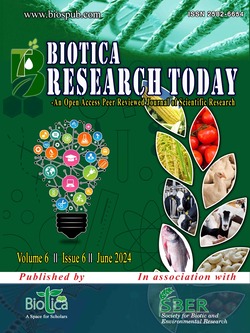
Bioremediation: A Novel Approach towards Waste Management
Shivali Dhiman
Dept. of Vegetable Science, College of Horticulture and Forestry, Neri, Dr. Yashwant Singh Parmar University of Horticulture and Forestry, Hamirpur, Himachal Pradesh (177 001), India
Balbir Singh Dogra*
Dept. of Vegetable Science, College of Horticulture and Forestry, Neri, Dr. Yashwant Singh Parmar University of Horticulture and Forestry, Hamirpur, Himachal Pradesh (177 001), India
Shiv Pratap Singh
Dept. of Vegetable Science, College of Horticulture and Forestry, Neri, Dr. Yashwant Singh Parmar University of Horticulture and Forestry, Hamirpur, Himachal Pradesh (177 001), India
Anuj Sohi
Dept. of Vegetable Science, Dr. Yashwant Singh Parmar University of Horticulture and Forestry, Nauni, Solan, Himachal Pradesh (173 230), India
DOI: NIL
Keywords: Bioremediation, Climate, Quality, Vegetable
Abstract
The environment quality directly linked to life’s quality on earth. In the present scenario due to the increasing growth and development in the human society, the stability in the climate is drastically changing. Due to the increase in manufacturing industries and intensification in agriculture, results in release of harmful chemical compounds which leads to soil and water contamination. Therefore, we need a biological mechanism with which we can enhance the quality of our life by transforming and eliminating the organic or inorganic pollutants. Bioremediation is considered to be the best alternative nowadays for removal of these contaminants from environment. Bioremediation uses natural occurring microorganisms (fungi and bacteria) used to remove environmental contamination. This biological mechanism is safer than the existing physical and chemical treatments.
Downloads
not found
Reference
Azubuike, C.C., Chikere, C.B., Okpokwasili, G.C., 2016. Bioremediation techniques - Classification based on site of application: Principles, advantages, limitations and prospects. World Journal of Microbiology and Biotechnology 32, 180. DOI: https://doi.org/10.1007/s11274-016-2137-x.
Bera, L., Pradhan, S., Saha, D., 2020. Green bioremediation technology. Biotica Research Today 2(8), 792-793.
Kumar, N., Tyagi, B., 2020. Bioremediation: Principles and application in environmental management. In: Bioremediation for Environmental Sustainability: Toxicity, Mechanisms of Contaminants Degradation, Detoxification and Challenges. (Eds.) Saxena, G., Kumar, V. and Shah, M.P. Elsevier Inc. pp. 3-28. DOI: https://doi.org/10.1016/C2019-0-01053-9.
Saha, J.K., Panwar, N., Singh, M.V., 2010. An assessment of municipal solid waste compost quality produced in different cities of India in the perspective of developing quality control indices. Waste Management 30(2), 192-201. DOI: https://doi.org/10.1016/j.wasman.2009.09.041.
